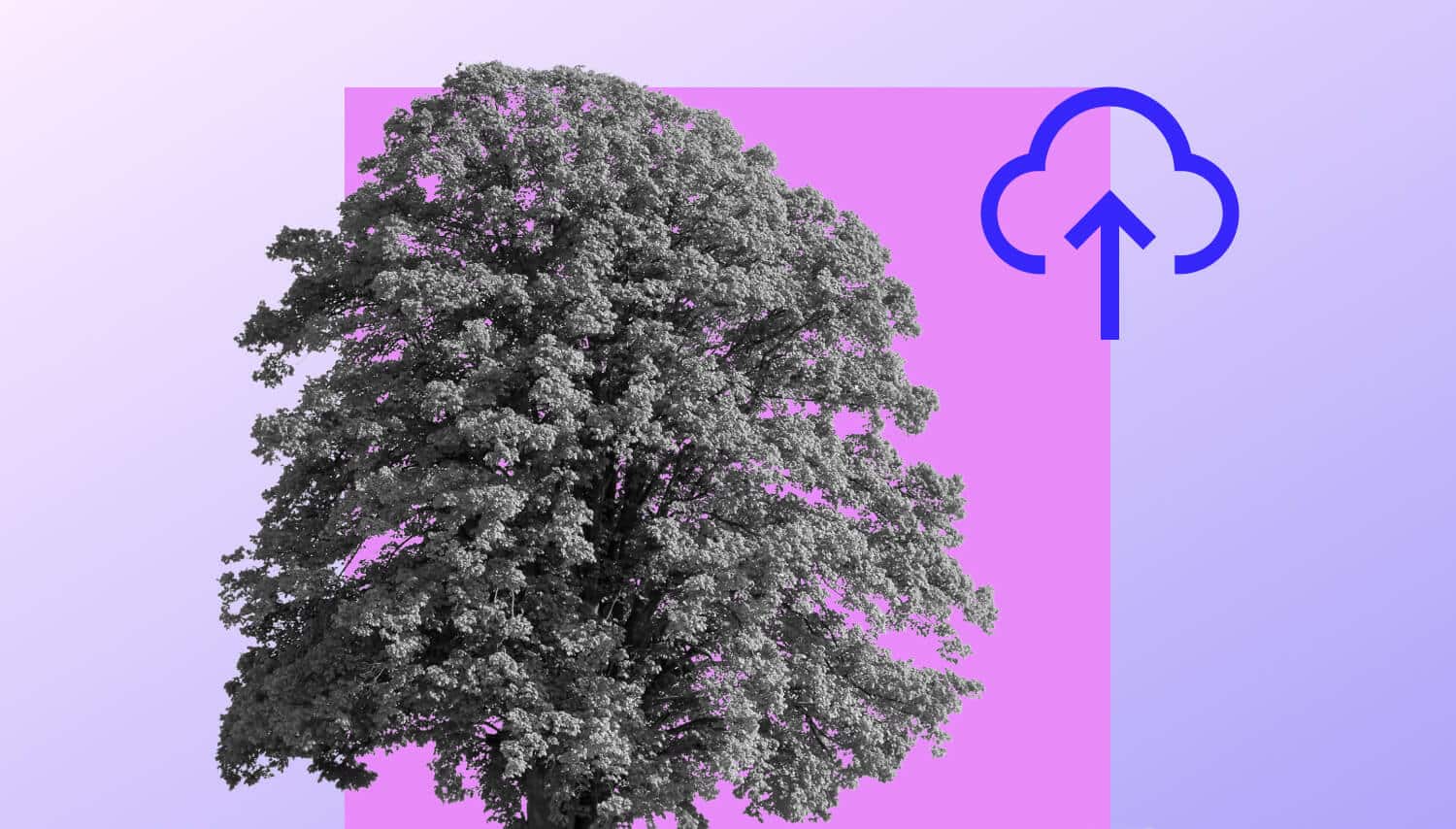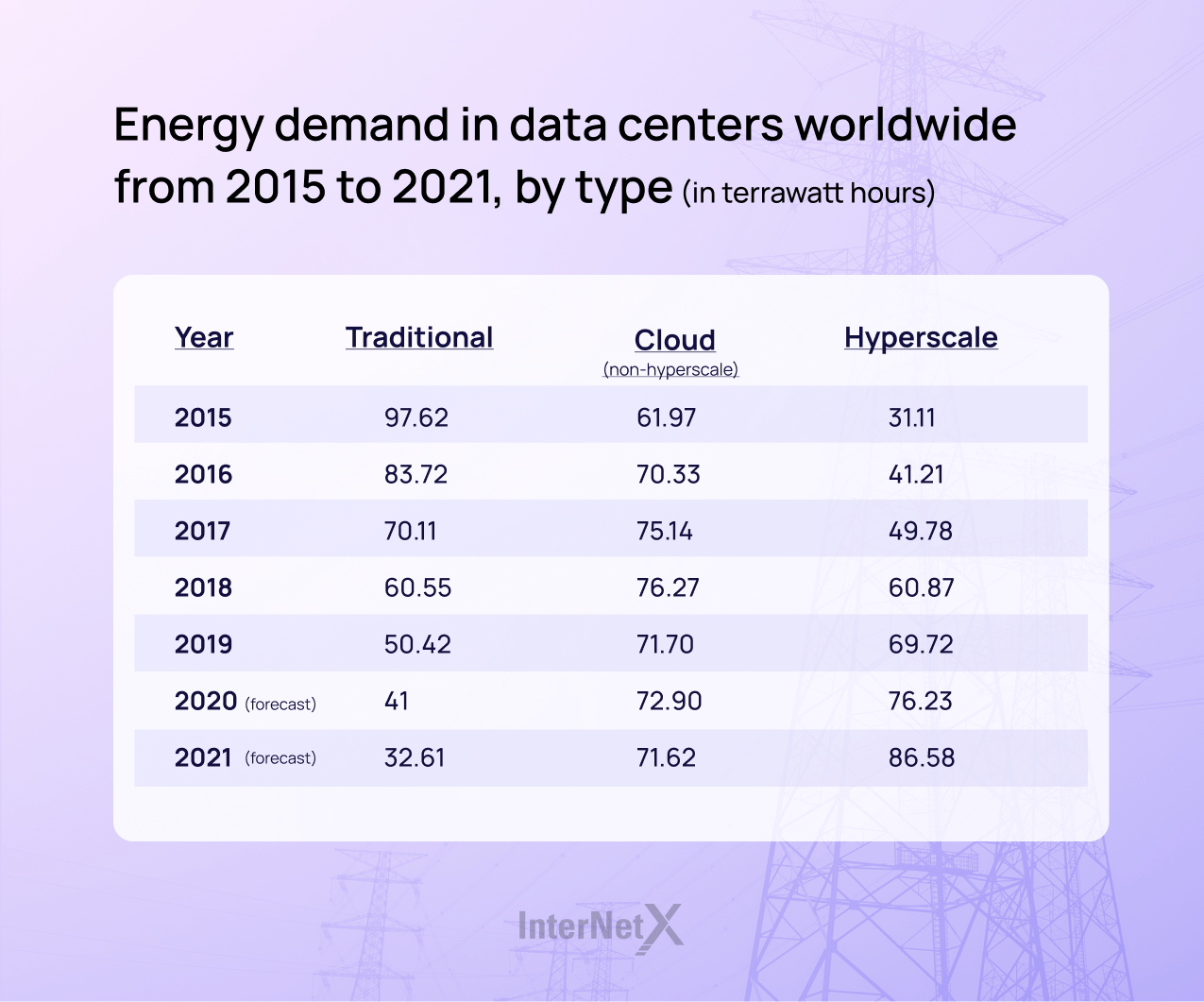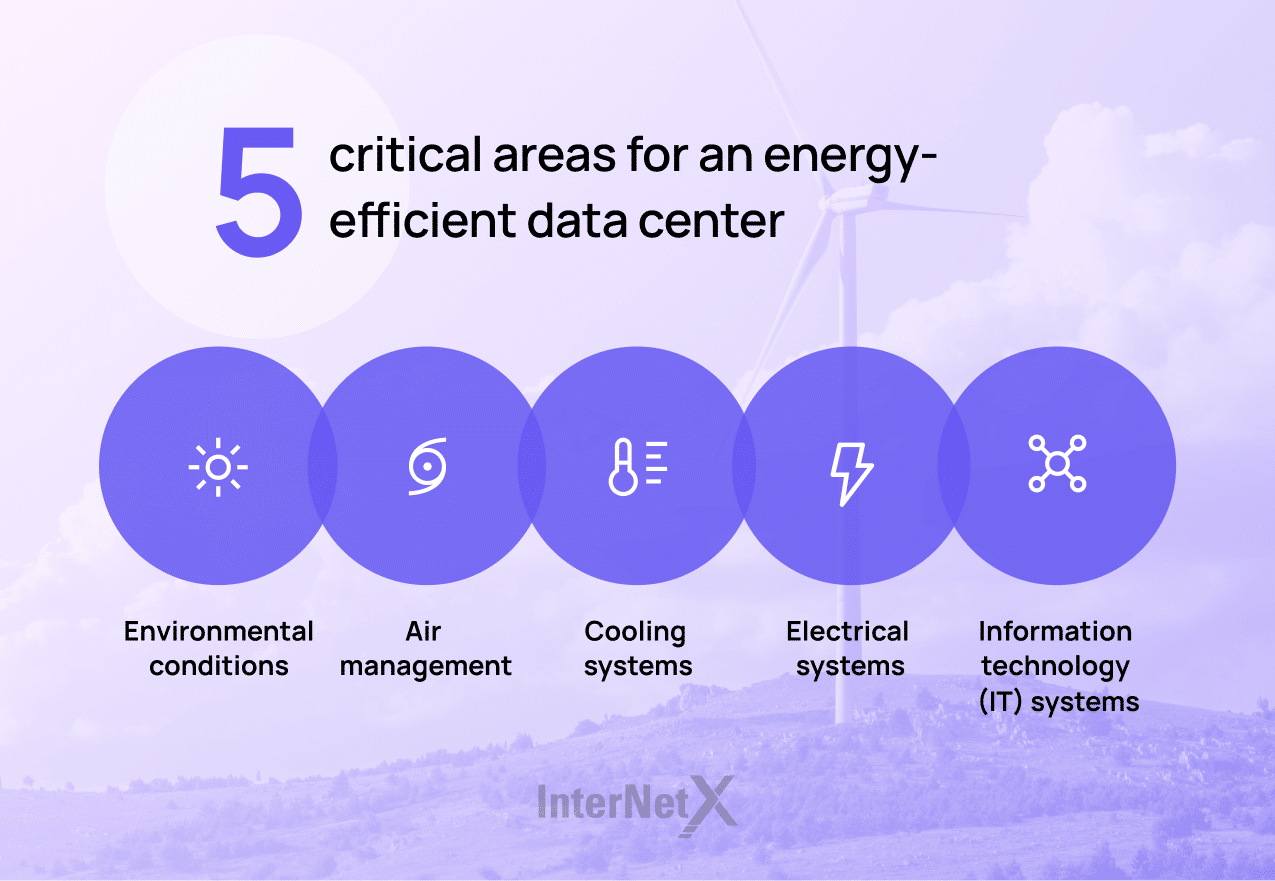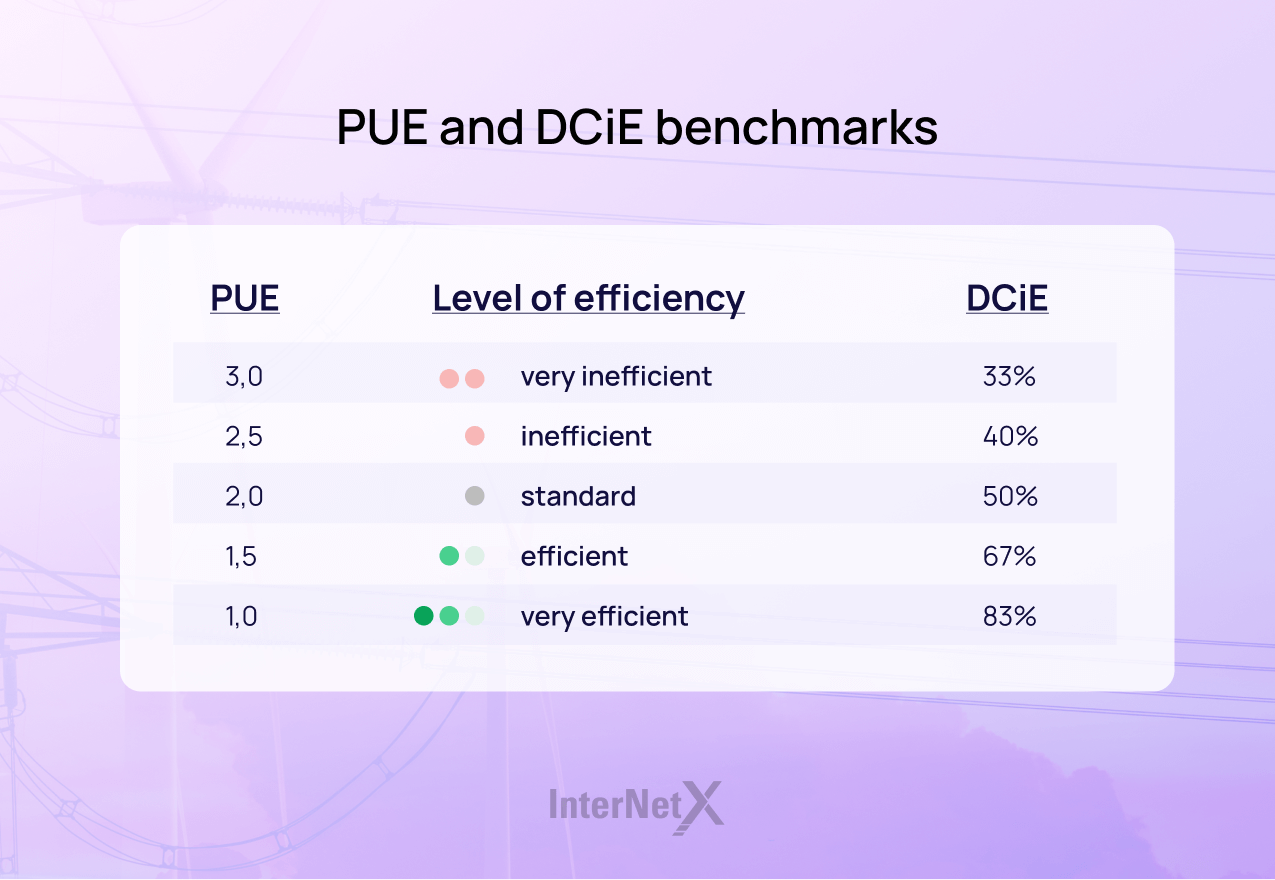
Green data center | Enjoy success with ecological sustainability
Data centers frequently come under fire for their high energy demand, but their energy efficiency can be improved significantly. But, what does it take to run a green data center?
Published by

Simone Catania
Date

The need for computing capacity is growing enormously. Data centers keep websites and online services live 24/7. They have become the heart of our digital era. These facilities are no longer small rooms with just a handful of servers but contain several thousand devices and are many hectares in size.
Running a data center is heavy on energy consumption. At InterNetX, we have set a new direction for sustainable hosting. Combining performance, energy efficiency and ecological goals has become part of our mission. Find out what running a green data center means and why we’ve partnered up with EMC Home of Data to plant four trees for every rack we operate in your name!
Green computing – when IT aims for sustainability
After decades of political action that failed to consider environmental protection, governments and organizations all around the world are now switching their focus towards solutions for climate, nature and pollution. With a better awareness of the topic, the world is now taking more stringent measures to relieve the environment, drastically reducing CO2 emissions.
With the increasing and widespread use of smart devices connected to the internet, the need for more sustainable technology has grown over the years. In our modern world, exclusively paying attention to material waste is not enough. We need to focus on the resources required to maintain digital services and how to run them in a manner that is more sustainable for the environment.
In this scenario, the tech sector is making its contribution as well. We define green computing as the emerging discipline that outlines how ICT can become greener and more environmentally sustainable. This is achieved by applying higher environmental standards to the production, use and disposal of information technology.
The term green computing originated in 1992, when the U.S. Environmental Protection Agency launched Energy Star, a program aimed at the evaluation and promotion of energy efficiency for monitors and other electronic equipment.
Why are data centers problematic for the environment?
Data centers have been strongly criticized for consuming energy heavily. In recent years, data centers have accounted for between 1 to 1.5% of the world’s total energy consumption. According to the U.S. Department of Energy, they consume 10 to 50 times the energy per floor space of a typical commercial office building. They must run non-stop 24/7 and thus demand a great deal of electricity to keep the servers active and functioning.

The industry is now moving towards new values for data centers that go beyond the classical performance factors, including low energy consumption, longevity and ecologically conscious processes. Ecological concepts are no longer a nice-to-have, but have become fundamental features of data centers.
Towards a green concept for data centers
Can data centers become more eco-friendly? Hardware, software houses and engineering have come together to find remedies and measures to tackle the issue and commit to a greener approach. For example, many data centers have started relying on low-consumption servers with natural ventilation and renewable energy sources such as wind or photovoltaic energy.
To design an efficient green concept for the data center, we must address all energy-related elements. We can divide them into three main categories:
- The equipment, like server racks, computers, cable management
- HVAC (heating, ventilation and air conditioning)
- The facility’s location, configuration and construction
As part of the Federal Energy Management Program (FEMP), the national laboratory of the U.S. Department of Energy published a guide to provide an overview of best practices to design an energy-efficient data center.
A data center designed along these lines will make better use of space while increasing performance and effectiveness. The elements to consider in this green design span all categories of information technology (IT) systems and their environmental conditions, data center air management, cooling and electrical systems, on-site generation and heat recovery.
These measures have a cascading effect on secondary energy savings for the mechanical and electrical systems.

What is a green data center?
Simply put, a green data center is a facility that minimizes its environmental impact. It has become possible to save valuable resources and be more eco-friendly. A green data center will consider the following critical aspects:
- Efficient use of electricity and water
- Operations with reduced production of CO2
- Equipment made using eco-friendly and long-lasting materials
- Sustainable optimization throughout the life cycle
- Accurate measurements and transparency must also be guaranteed
All these factors are closely intertwined and influence one another in assessing how green a data center is. Let’s clarify this aspect by considering an essential element within the data center, namely temperature.
Activating mechanisms to reduce the temperature within a data center costs significantly more than constantly keeping it low. This is why it must always remain within a defined range, ideally room temperature. This ensures a long life span of the equipment and good profitability. The architecture of a data center and the building materials also play a role in maintaining the right temperature.They should help derive heat from rooms with as little effort as possible. Intelligent positioning of the walls, pipes, and server cabinets ensures short distances for the heat to be transported. As you can see, a green data center is a mixture of different elements that create a facility with a lower impact on the environment.
This is what a green approach entails
A green data center relies on clearly defined principles to protect the environment with verifiable and sustainable measures. These are some examples of what green data centers do:
- Include external elements for improving heat dissipation or internal components such as airflow design
- Rely on low-consumption servers with natural ventilation and renewable energy sources such as wind or photovoltaic energy
- Switch to free cooling or free chilling systems, far more sustainable than traditional air conditioning systems
- Implement multiple strategies to reduce energy consumption, for example, through energy storage or solar panels
- Avoid wasting the energy that powers the cooling systems and reuse it to heat neighboring buildings and other industrial structures
- Locate the facilities in regions where temperatures are low to take advantage of natural cooling
- Use high-quality materials for a longer life cycle
However, these options are only part of the solution to the problem. Sustainability must be a central element in the facility’s design. No single technology determines whether a data center is green or not. Ethos and a real commitment to the environment are essential requirements!
Measuring the energy efficiency of a data center
Standardized metrics and benchmarks can now calculate the energy efficiency of data centers worldwide. Those used most commonly are Power Usage Effectiveness (PUE) and the Data Center Infrastructure Efficiency (DCiE). Both were proposed by the Green Grid, which is a member of the Information Technology Industry Council (ITI), a premier trade association that works to advance public policies for the tech sector.
Power Usage Effectiveness (PUE)
The PUE is the ratio of energy consumed by a data center, including power for auxiliary systems such as air conditioning and lighting.

The ideal PUE value of a data center should be equal to 1. According to Green Grid’s assessments, the average PUE worldwide is about 1.8 nowadays.
Data Center Infrastructure Efficiency (DCiE)
The DCiE calculates the energy absorbed by the IT equipment in relation to the total energy consumed to run the data center. DCiE is the inverse of the PUE.
It is important to note that these benchmarks need to be measured regularly on different days of the week and at various times to produce meaningful results.
InterNetX data center – going for green
Environmental engagement is one of the cornerstones of our business. We continuously assess what we can do to work more sustainably and what we can do for our clients to be part of the green economy. This is why we are committed to running a green data center! These features enable the InterNetX data center to make your online presence greener:
- We use 100% energy from renewable sources. Solar panels generate part of this energy thanks to 1,777 hours of sunshine annually. Additional energy requirements are covered entirely by hydropower.
- Cold-aisle containment reduces the volume of air that needs to be cooled.
Thermals on the roof cool down the equipment. - Threefold room height lets the waste heat rise without affecting the devices.
- Dell EMC servers offer a much longer lifespan than comparable providers.
- With a PUE of 1.2% our data center is classified as very efficient.
Racks4Roots: a tree for every operated rack
Despite all optimizations, data centers still consume a lot of energy, also when green. To compensate for this CO2 footprint, we have now committed ourselves to a tangible green action!
In cooperation with EMC Home of Data, we will plant four trees every year for each rack we operate. The project Rack4Roots aims to give back to nature what we as a company and humans take. As an InterNetX customer, you will become part of this environmental commitment, making the planet greener!
Choose a green hosting service





